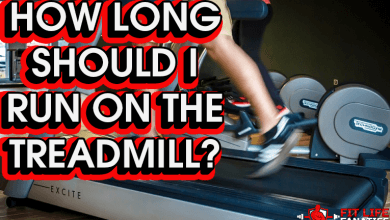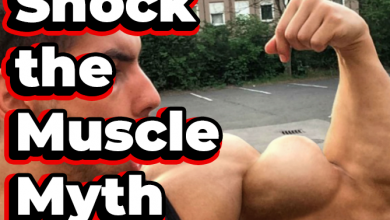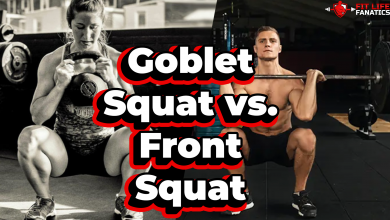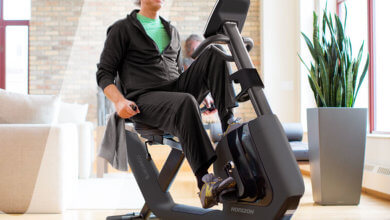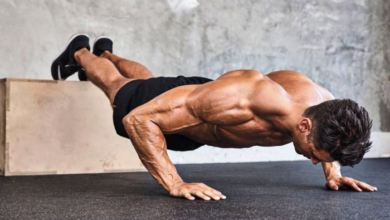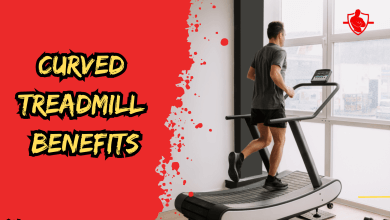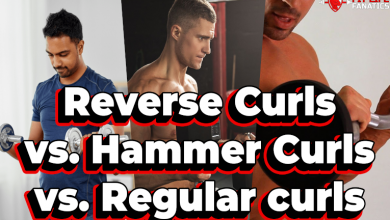Are Rowing Machines Bad for Your Back? – Separating Fact from Fiction
Back pain, whether chronic or acute, is a common problem for Americans, with about 65 million reporting experiencing it on a regular basis. Around 16 million of those have persistent or chronic pain.
In fact, that means approximately 8% of all adults in the USA are affected by back pain.
While poor lifestyle choices and sedentary jobs can lead to back problems, having a weak back is often the result of poor fitness. This is where the classic rowing machine comes in.
However, the question remains: is it safe to use rowing machines, or could they worsen pre-existing back issues?
Let's separate fact from fiction and find out whether rowing machines are bad for your back.
I will also take you through the different types of rowers, how to use them for the best results and least risk of injuries.
Types of Rowing Machines
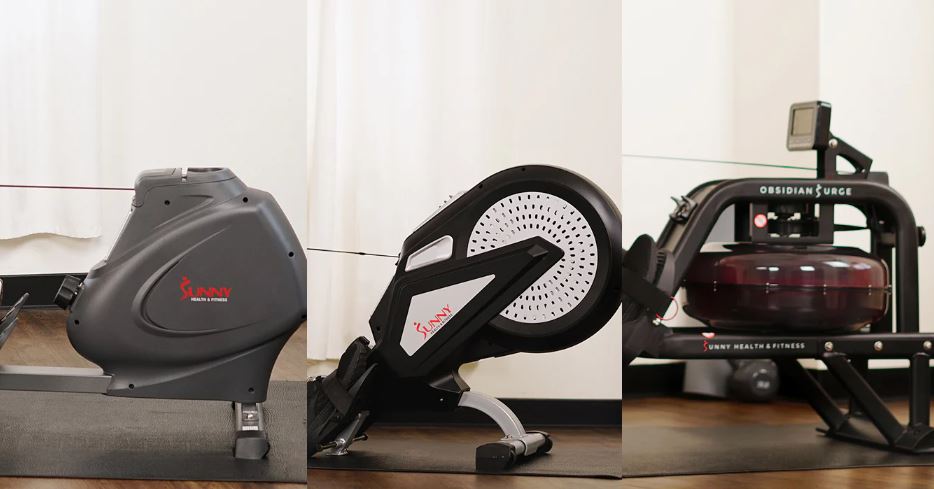
Before getting into the good, the bad, and the ugly of rowing machines, let’s first take a look at the different rowing machine resistance types. These machines often come in four types of resistance designs; magnetic, hydraulic, air, and water rowers.
The one you go for is all up to you, so let’s look at each type;
Magnetic Rowers
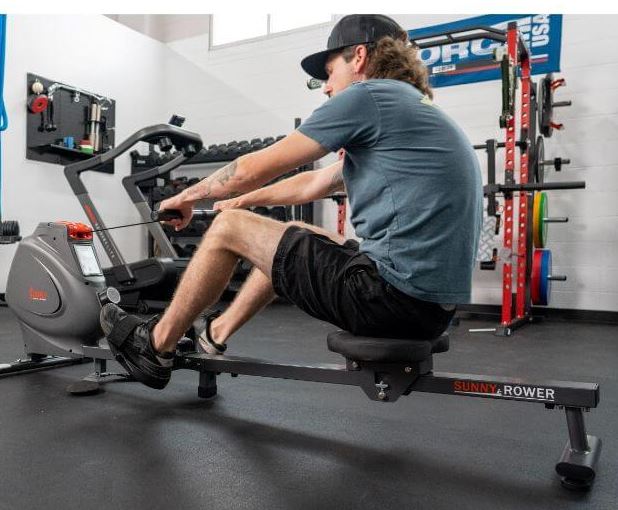
Magnetic rowing machines, as the name implies, feature a strong magnet that tags on a flywheel attached to the handle. As you adjust the resistance, you draw both the magnet and the flywheel closer or apart.
This type easily blows the rest out of the water. They’re quiet, cool to use, and still, very compact and easy to move around. The ease of movement helps guys with back problems since the compact and lightweight design of these machines makes them easier to move around if needed.
This right here is the sort of resistance I’d vouch for if anyone with concerns about their back needed a rowing machine.
You’ll still get in a decent workout with a magnetic rower, but (of course) as is the case with any other rower type, this one too has its benefits and downsides.
Advantages of Magnetic Rowers
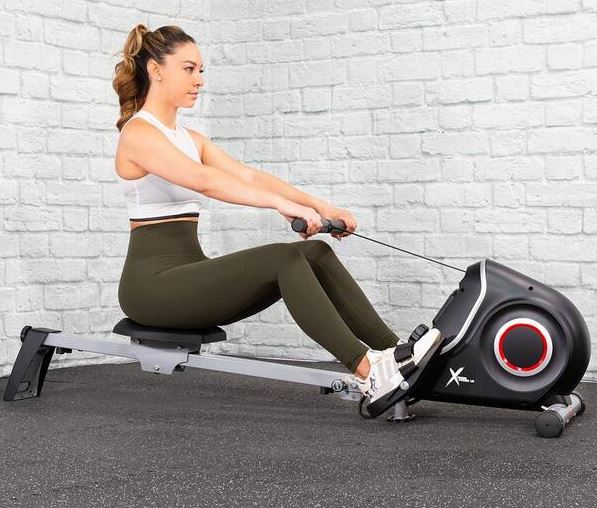
- There’s a variety of resistance levels to choose from
- They are whisper-quiet and smooth
- Often more compact and lighter than others
- Require less maintenance
Disadvantages of magnetic rowers
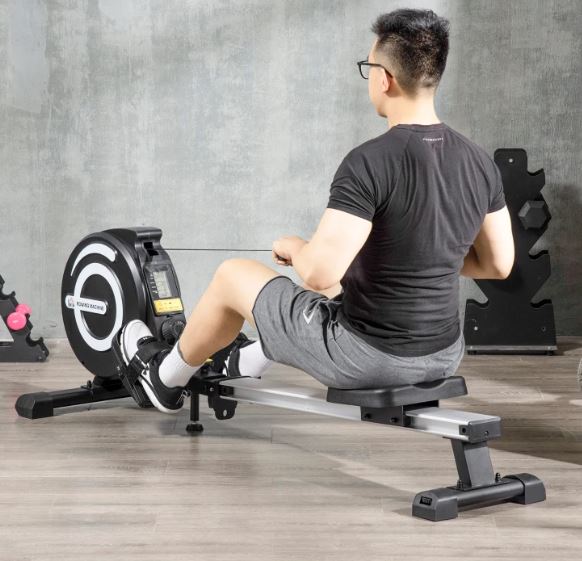
- You don’t get to simulate the action of rowing on the water
Hydraulic Rowing Machines
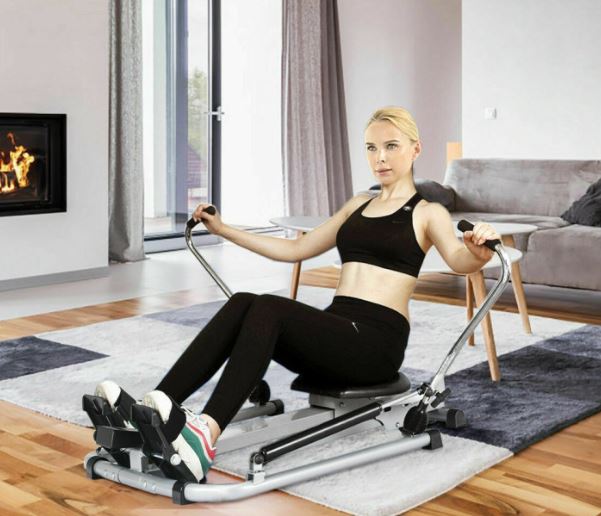
If you can’t get your hands on a magnetic rower, a hydraulic one is as close as you can get to the experience that the former offers. These rowers too are compact (at least they are more compact than water rowers) and quieter too.
The only shortcoming you will run into with hydraulic machines is that they don’t offer as much smooth workouts as the other resistance types, the workout will be decent, but might not be very comfortable. They also don’t last very long.
Hydraulic rowers work by having a cylinder with air or fluid, and pistons attached to the handles. As you pull the handle, you are working against the liquid or air in the cylinder.
These machines allow for resistance adjustments by using either clamps or levels.
Advantages of Hydraulic Rowers
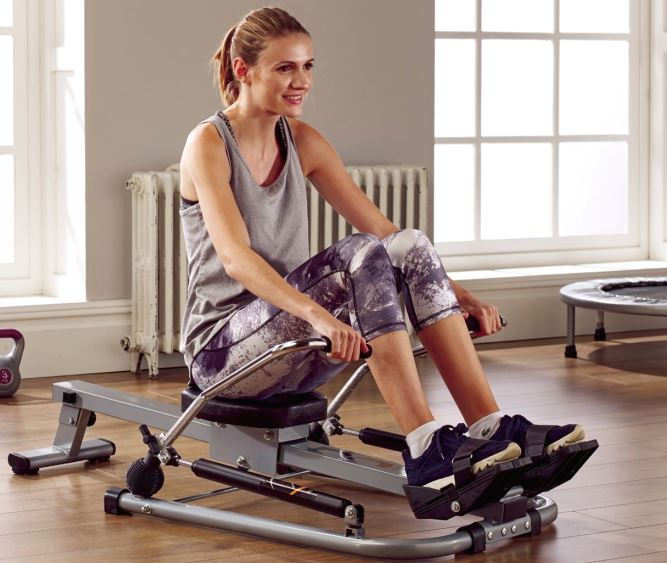
- They are low cost and thus more affordable
- They are more compact, most of them being foldable
- They are also more quiet compared to water and air rowers
Disadvantages of Hydraulic Rowers
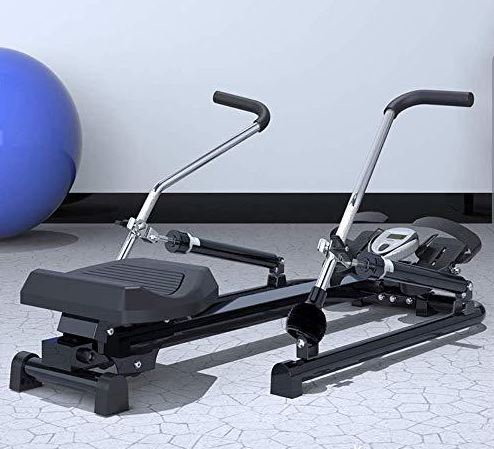
- The action is not very smooth
- You need to do regular maintenance
- As the oil heats the resistance does change
Air Rowing Machines
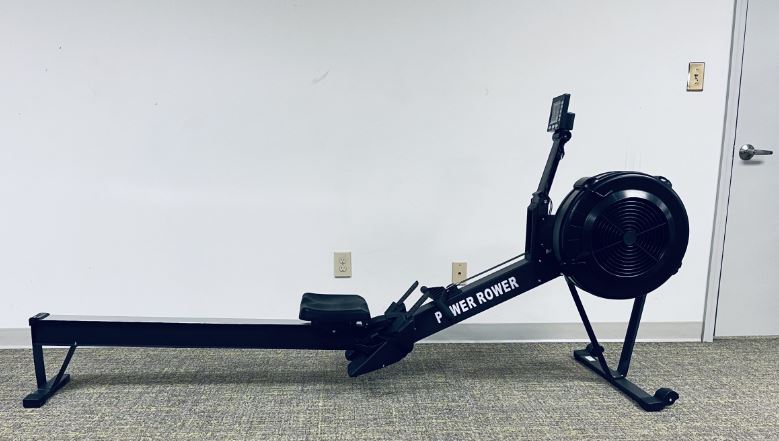
This type of resistance is among the most popular ones on the market, and it’s widely loved by rowing enthusiasts across the fitness spectrum.
Also known as ergometers (ergos in short) produce resistance by using airflow over a flywheel, and the wheel is connected to the rowing handle so when you pull you spin the flywheel.
The faster you go on the handle, the harder it gets as the flywheel spins faster.
Some advanced models have dampers that change the air movement and thus enhance the feel of each stroke. Air rowers aren’t as compact or quiet as magnetic ones, but still, they catch the fancy of most internal rowing enthusiasts.
Advantages of Air Rowers
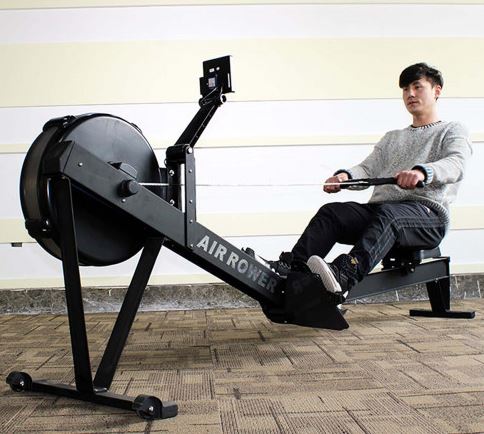
- The variety of resistance levels is amazing
- You almost feel like you’re rowing on water
- The action is quite smooth
- Little maintenance thanks to low wear and tear
Disadvantages
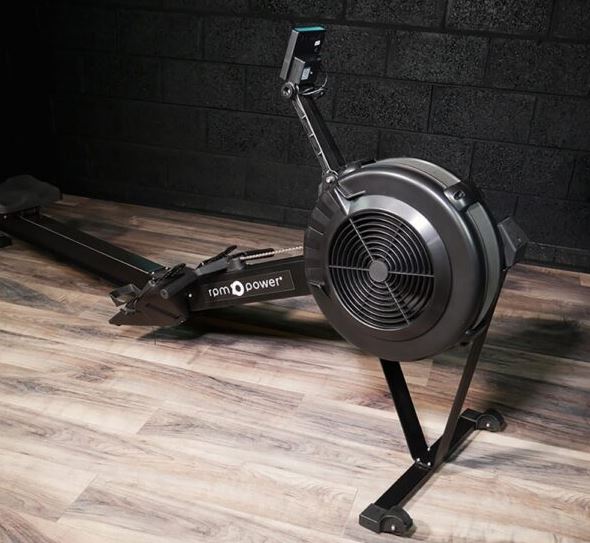
- They can get a bit too noisy for home use
Water Rowers

If you want to get as close to that aquatic experience as you can, then a water rower is the sort of machine to go for. These units feature a flywheel (with paddles) positioned inside a tank full of water, so when you yank on the handle the paddles move the water in the tank.
This creates the resistance you need for your workout. The only thing that makes water rowers less ideal for people with concerns about their back health is these machines' weight.
These machines tend to be massive, and hefty, you don’t want to be moving them around so often, especially with the tank filled.
Water rowers are also significantly noisy compared to magnetic rowers, but hey, some people love that “Whoosh” sound from the water moving inside the tank. Besides, the operation is smooth, and you get in your desired cardio to the max.
Advantages of Water Rowers
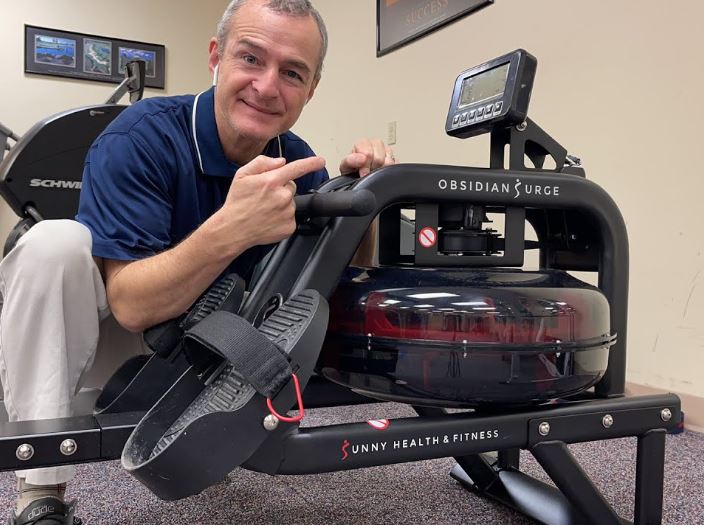
- The operation is smooth
- It’s as close to the real thing as you can get
- The resistance is consistent throughout the stroke
- They don’t need very frequent maintenance
Disadvantages

- They are large and heavy
- The price point is quite high
How Rowing Machines Work
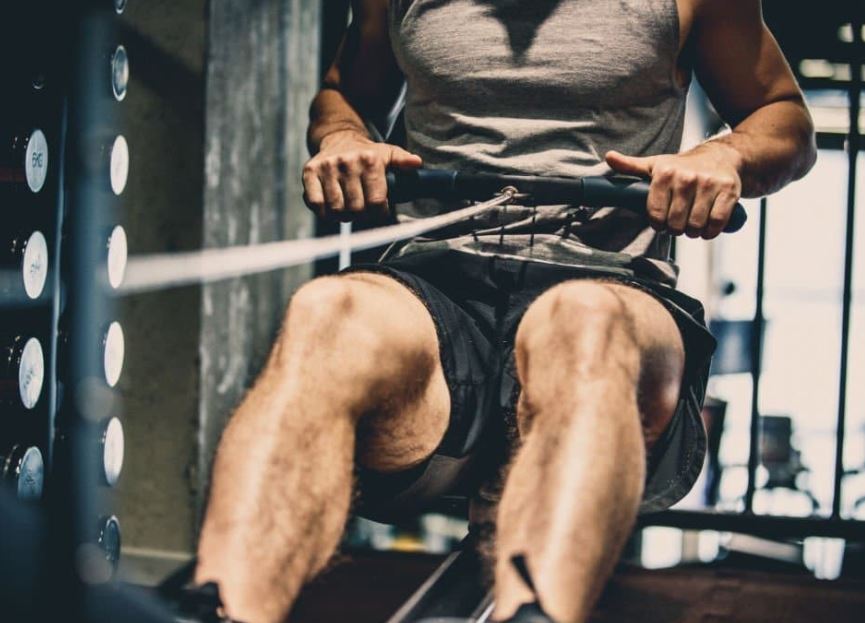
Rowing machines give you the same motion as rowing on water, without requiring you to purchase a kayak or boat.
With an indoor rowing machine, you can enjoy a full-body workout every other day from the comfort of your apartment home gym, without having to leave the home.
Unlike traditional rowing with two paddles, indoor rowing machines use a handle that you'll pull back and forth in a precise motion.
This can be especially useful during repetitions, as the consistent movement can help improve your form and technique.
Unlike paddles, which can move independently, the handle on a rowing machine will keep you performing the same motion throughout your workout.
Whether you’re looking at premium or budget rowing machines, most of them will give you a bunch of extras and adjustability settings. You’ll most likely be able to adjust the position of your feet or perhaps the height of the seat.
You’ll be able to change the resistance as well, not to mention other extras like water bottle holders or perhaps a small fan to keep you cool.
Your workout metrics are normally displayed on a small screen, whether you care more about the calories you burn, the time or the distance.
Using a Rowing Machine – The Right Way
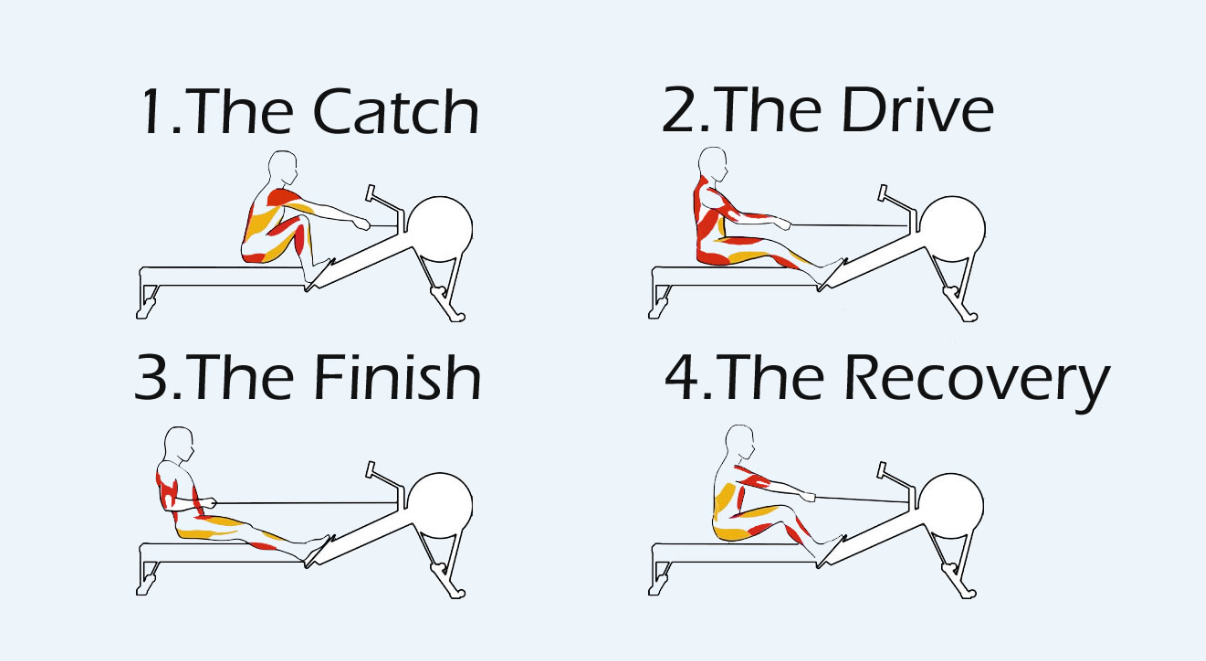
When it comes to using a rowing machine, be it a bare-bone model or an advanced one with all the bells and whistles, the drill is the same.
You start with the Catch, proceed to perform the Drive, hit the Finish, and the Recovery.
However, nailing each f these phases, and transitioning smoothly from one to the next could not only help you achieve a lot with your rowing, it’s essential for preventing injury and back issues.
What should you be doing in each of these phases?
Let’s find out!
The Catch
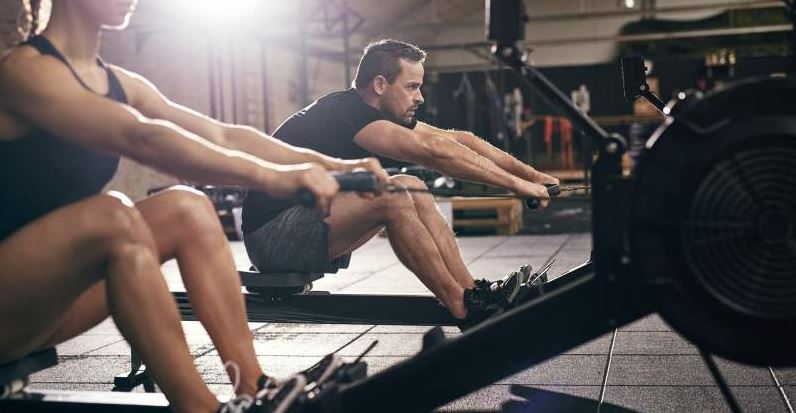
The catch is the initial force exerted on the water with the blade to get a boat in motion when paddling.
With the indoor rowers, however, we don’t have a boat to paddle forward, so the catch here comes in the form of the initial effort exerted on the rowing machine's handle.
Efficiency is indispensable here, so every consecutive stroke needs to be as smooth as it can get.
The idea is to keep your hands moving at this phase. It all comes down to how you finish the recovery phase (we’ll get to that in a bit) so that you keep the move connected and fluid.
At this phase, your arms should be slightly (loose) relaxed, with your lats, glutes, lower back, and quads kicking in to engage your feet and connect the catch to the initial drive.
The Drive
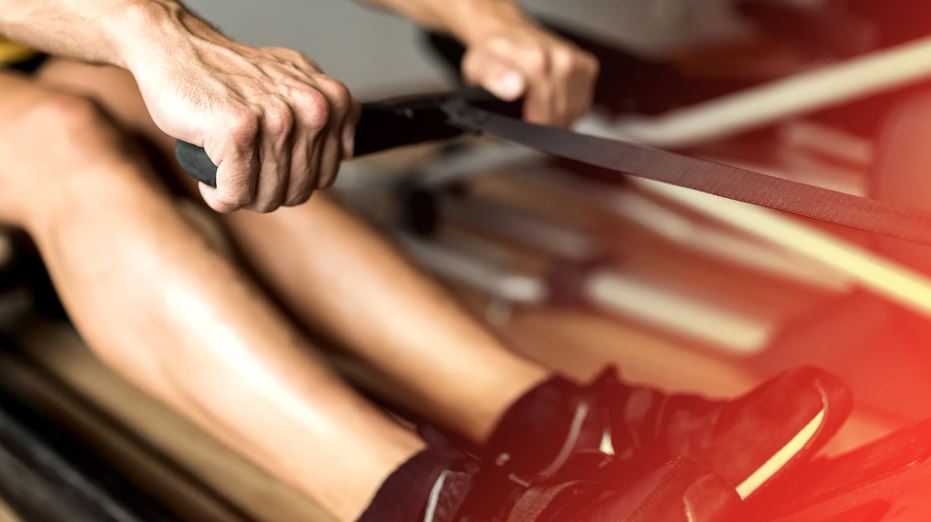
After the catch, you transition to the drive phase – the most dynamic section of the entire stroke. It all starts from the legs, then the resistance is transferred to your body, and then to your arms.
Remember, your legs should bear the brunt of the resistance here.
Your back, arms, and shoulders should only being involved once your legs are at around 80% of extension as you’re completing the highest point of resistance in the drive phase.
Engage the back, arms, and shoulders too early, and they will take the pressure off your legs. Thus you won’t be able to recruit your quads and glutes as much as you should.
You also risk ending your stroke prematurely and putting your back on the line.
The Finish

Having let your legs grind it out for 80% of the drive phase, your body and arms can take over and finish off the remaining portion of the stroke, which is the finish.
This is where the resistance of the stroke dies down before entering the recovery phase.
The idea is to pass the resistance from the legs to the lower body, to the upper body, and then to the arms just before hitting full extension.
At this phase, your legs and hips should be at around 100 degrees with the core engaged as your arms pull the handle towards your chest to make the most of that last bit of resistance.
The Recovery
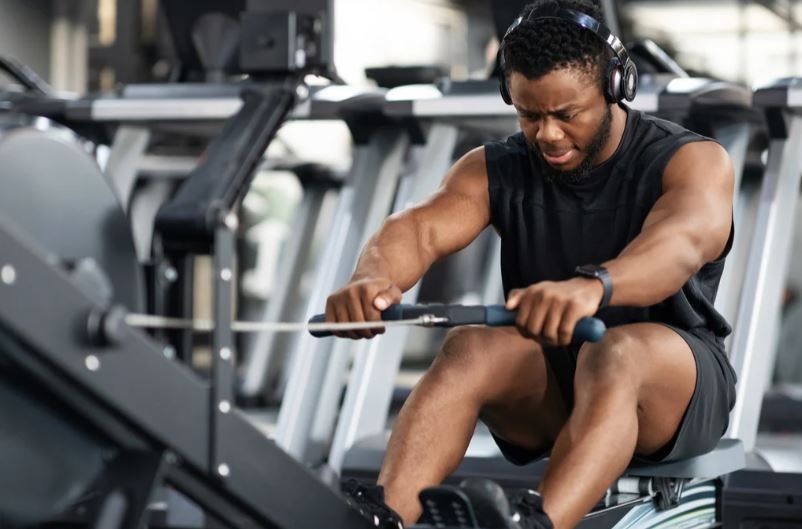
With the stroke over, the recovery phase is simply re-alignment to get back to the catch position.
In this phase, you need to extend your arms (smoothly) fully – easing them down and out so that the handle passes just above your knees.
Use your hips to hinge your body from leaning back until you lean forward.
Next, engage your hamstrings to bend your knees to have your shins in a vertical position as you draw close to the machine.
You follow the same process you did for the stroke, only in reverse. That is, instead of legs – body – arms, you go; arms – body – legs.
Now you’re full circle back to the start of the row.
There's still a whole lot more to nailing an almost picture perfect rowing machine workout.
This video goes into the extra tidbits that you should be keen on;
Benefits of Using Rowing Machines

Now, are rowing machines bad for your back? The truth is they come with a plethora of benefits. Whether you want one for your home gym setup or you go to a gym, you’ll notice there are plenty of them out there and people actually love them.
Full Body Exercise
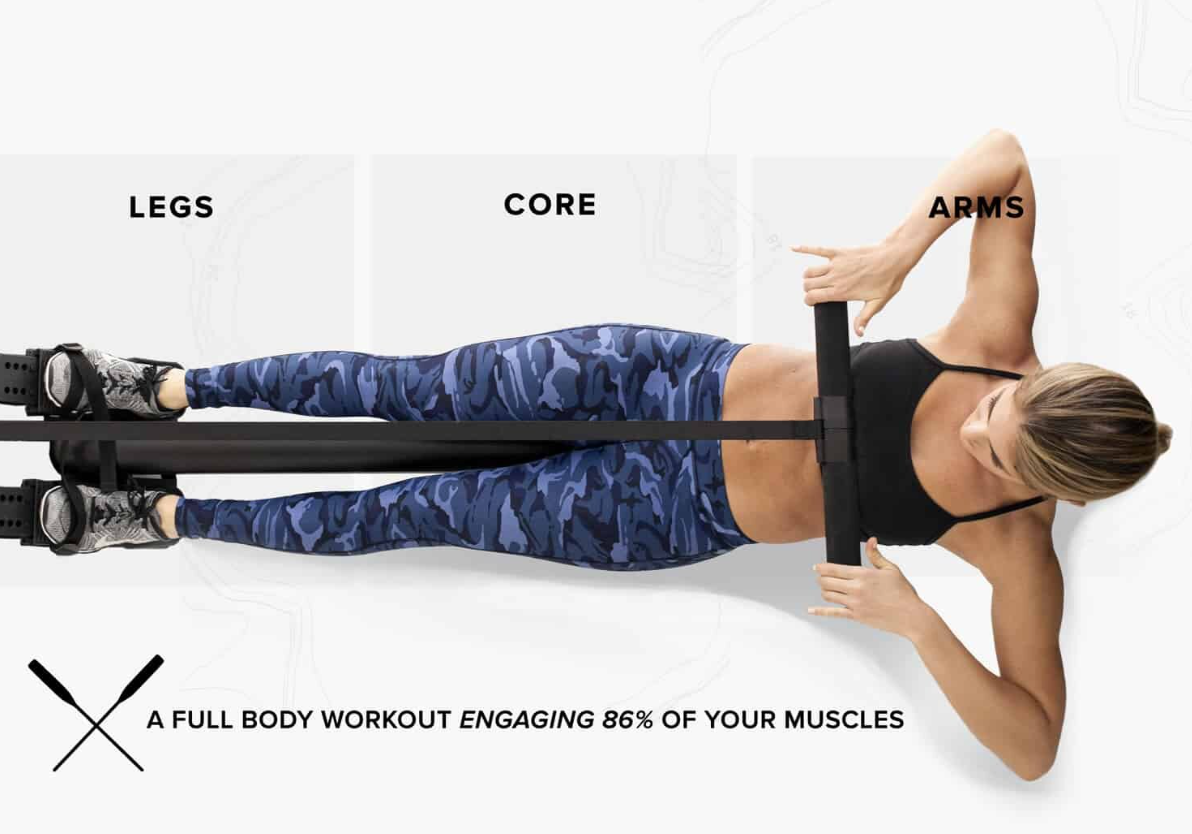
First of all, you’ll get a full body workout. Well, pretty much, you’ll build strong core, including the back, as well as your abs. Your arms do a bit of movement, so that helps too, not to mention your legs.
Rowing is considered a cardio exercise, so your heart will benefit from it too.
Of all these muscles worked by rowing, the lower back is likely to see the most significant benefits. However, you may be wondering, are rowing machines bad for your lower back?
Unless you are recovering from a severe back injury, using a rowing machine shouldn’t be a problem.
Another common question is are rowing machines bad for your knees. While it's true that the knees bend and straighten with each repetition, rowing is generally a low-impact exercise that does not put undue stress on the knee joints.
Unlike heavy power exercises like squats, rowing involves relatively little weight bearing on the legs. However, if you do experience discomfort, it's important to listen to your body and take it slow.
Endurance and Strength
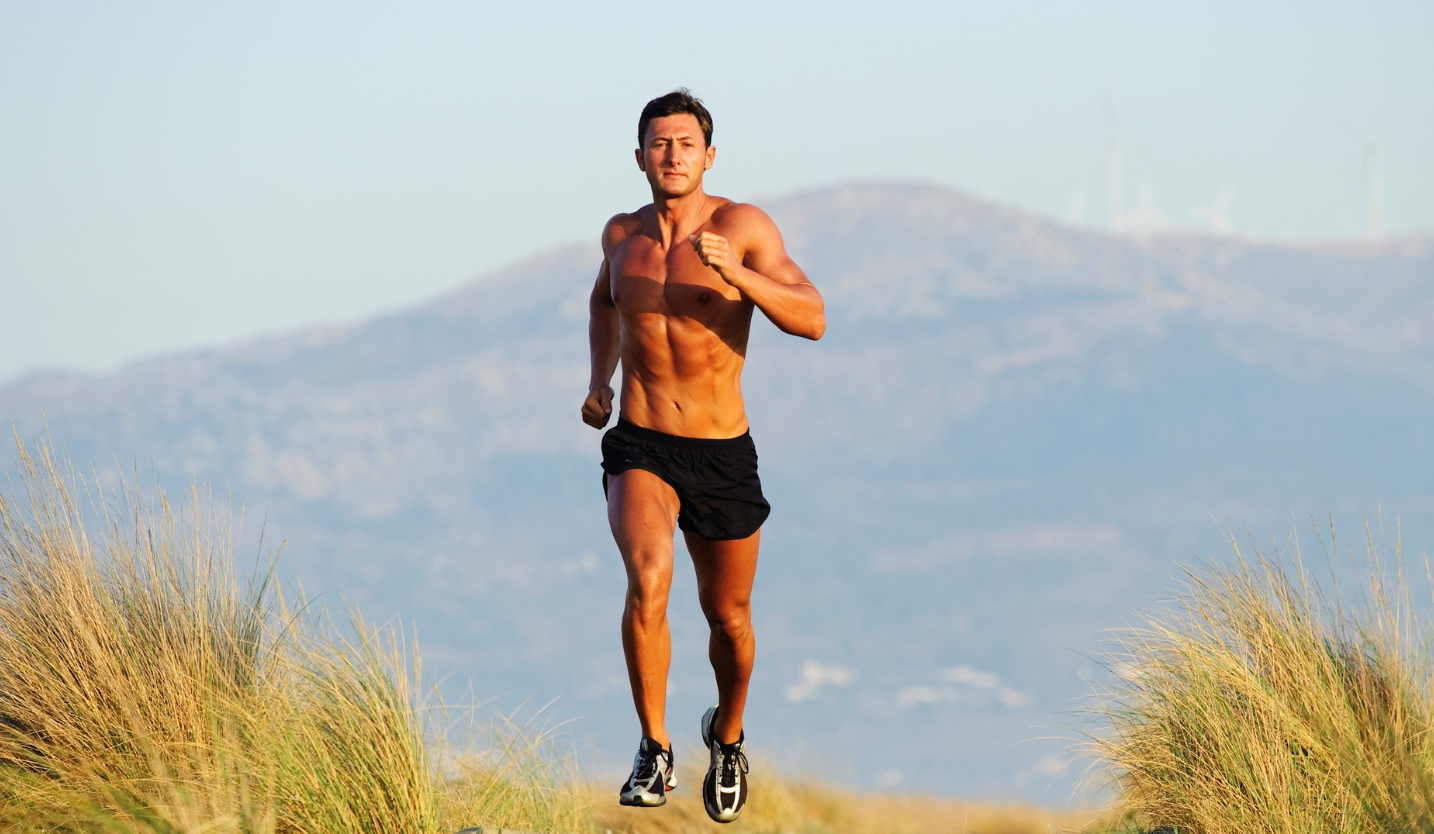
In the long run, it’s also likely to boost strength and your heart health, meaning it will build stamina and endurance. You’ll get lean and stronger back.
Plus, your body will be able to do more exercises, whether it's about chest leg workout or running after a leg day.
You’ll be able to perform all sorts of workouts without risking to injure your back.
Stronger and Rounded Butt

And to many of us out there who only care about getting a bubble butt, yes, you’ll be happy to find out that rowing on a regular basis will build a jiggly butt.
We all know what that means. You will get rounder, firmer and more attractive booty. But from a medical point of view, you should know that back pain doesn’t always start in the back, but in the hips.
When you work the legs and especially your glutes, you’ll basically work on the muscles supporting the back.
Bottom line, while you may get some rowing machine lower back pain after a workout, that’s the type of pain you want, the type of pain that will strengthen your back.
Obviously, you’ll have to keep the tension to an appropriate level to avoid going too far.
Are Rowing Machines Bad for Your Back?

So, are rowing machines hard on your back? The answer to this question is not a simple one.
While rowing machines may be highly recommended in certain cases, there are also situations where physiotherapists may advise against their use.
When I had a serious back injury in the past, a medical specialist advised me against using the rowing machine. So, if your back is fragile, rowing may not always be the most suitable activity.
And if your medical or fitness professional does recommend it, you’ll have to do it gently, with little to no resistance at all.
Other than that, rowing and cycling machines are highly recommended to keep yourself in good physical condition, tone up and strengthen your muscles for all kinds of daily activities.
In this article, I’ll discuss the benefits of indoor rowing, when this workout is recommended and how you can make the most out of it.
There are all kinds of situations and circumstances that make this activity unique for everyone and that’s your job to identify, but don’t worry, I’ll talk about everything here.
1. You have a serious pre-existing back injury
2. Your back is fragile, and prone to injury
Is Rowing Bad for the Lower Back?
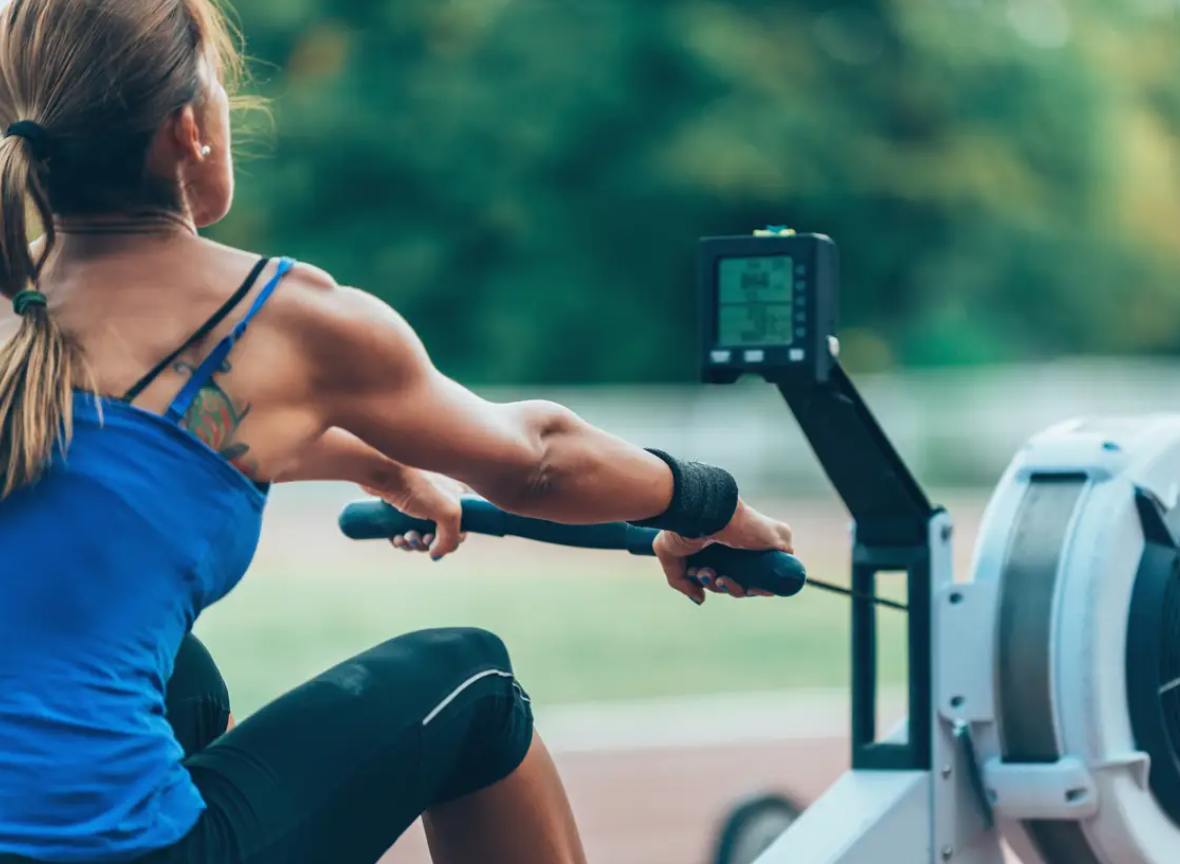
No, it’s not. No matter whether you do shoulders after chest day or arms workout after chest day, you’ll find the chest area to be sore, maybe for a day or two, depending on how experienced you are and how hard you do it.
It’s just how the human body works. You practically tear some muscle fibers apart and they grow back stronger.
Rowing is a cardio exercise, so it won’t be too intense. You’re more likely to feel the fitness exhaustion, rather than break your muscles.
But then, the extra tension on the lower back will make it stronger while relieving stress, despite most expectations.
A bit of tension down there is perfectly fine and actually recommended. Otherwise, it feels like the workout hasn’t been intense enough to show some improvement.
Again, I need to make it clear that a back with a permanent injury should take it easy and maybe even discuss this type of training with a professional.
On the same note, avoid this exercise if you’re recovering from an injury, unless recommended by a specialist.
Is Rowing Machine Bad for Posture?
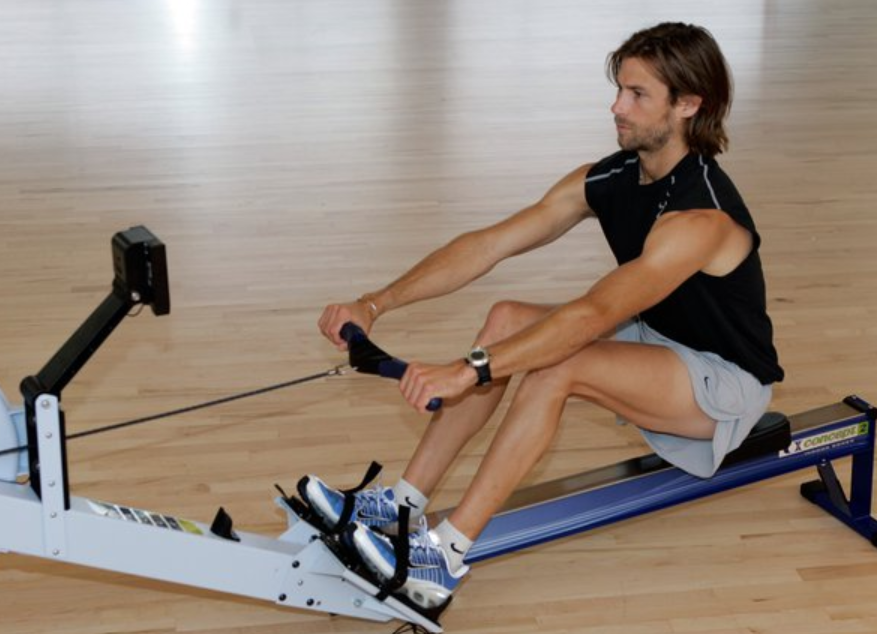
Performing the rowing exercise by the book will add strength to your core and back. What does that mean? Exactly! A better posture.
To gain as much as possible from this exercise in terms of posture, you’ll have to do it by the book though. Watching different videos online is not enough, you’d have to do it in front of a mirror and observe yourself.
The proper form implies sitting down with your back straight. The natural tendency is to hunch forward towards the end of each repetition.
Instead of hunching, you must lean. In other words, keep the back straight for maximum effectiveness.
3 Common Rowing Machine Mistakes
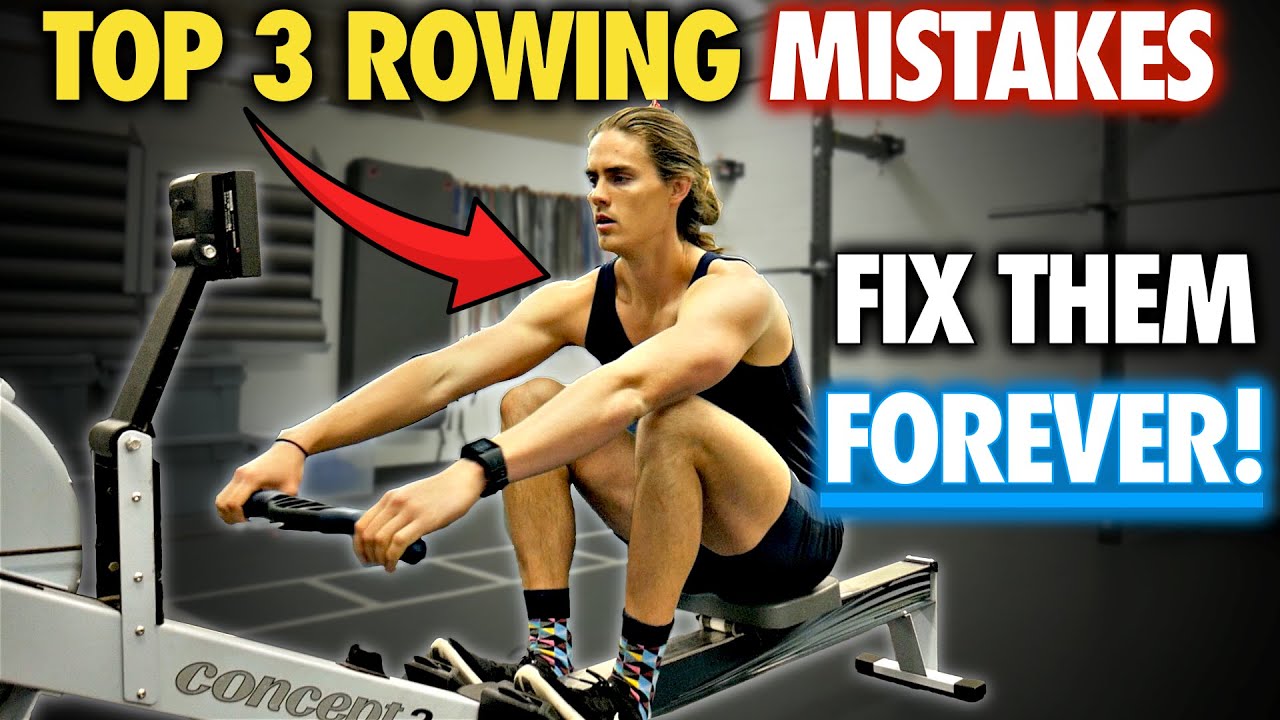
As someone who has spent a lot of time on the rowing machine, I've noticed that many people make the same mistakes when using this equipment.
Whether you're new to rowing or have been doing it for a while, there are certain things you should be aware of to make the most out of your workout and avoid injury.
Let me share with you three of the most common mistakes and how to correct them to maximize your workout.
Hunching Back
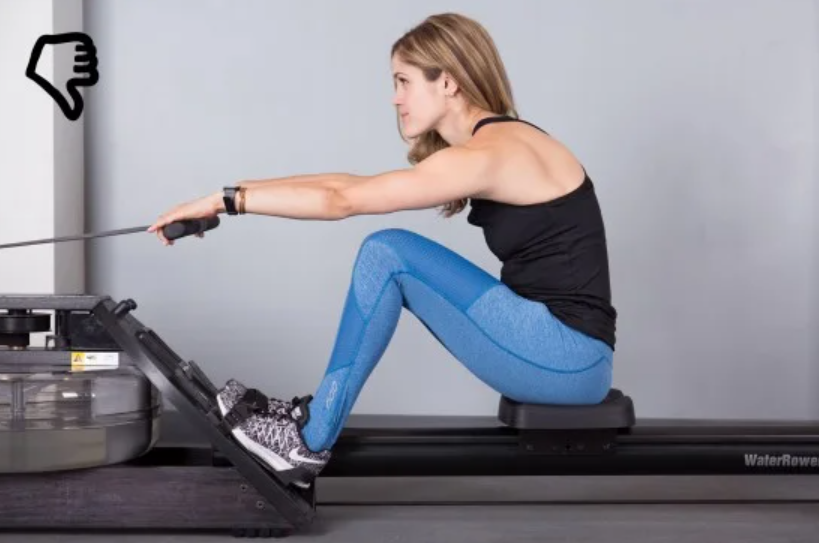
A hunching back will reduce the impact on muscles that really matter. It will put strain and unnecessary stress on the back.
This isn’t the tension you want in the lower back, but the type of tension that will target the middle and lower back, causing even more back pains in the long run.
It’s a natural tendency, I know, but that’s why I recommend paying attention to the form, whether you do it in a mirror or you actually focus to keep the back straight.
This mistake is more likely to occur towards the end of a repetition.
Leaning Back
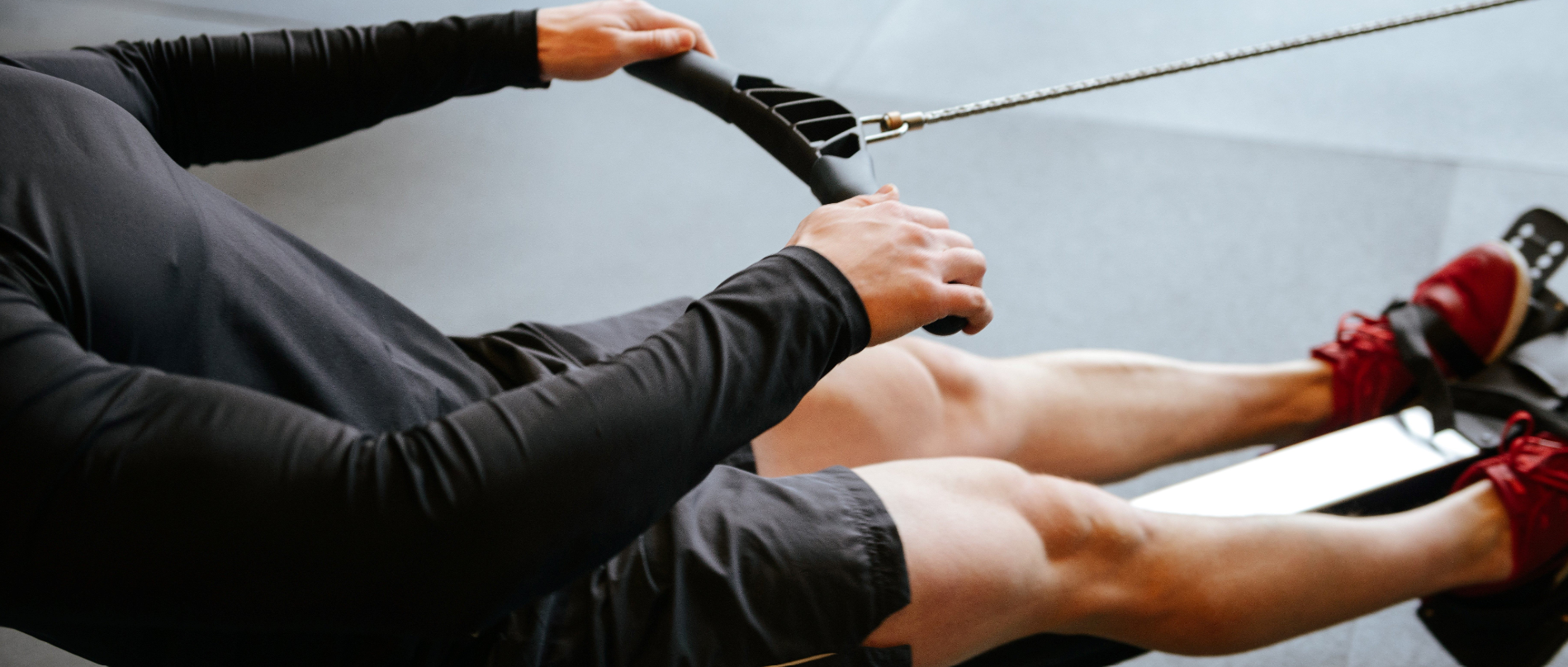
This is another natural tendency, as well as a mistake. During the middle of the repetition, you’re supposed to have the handle close to you, pulled by the abdomen.
Now, while slight movement is normal during this exercise, make sure you don’t use your body in the attempt to make the exercise easier.
Basically, as they pull, people also tend to lean back a little. They use the whole body to pull, rather than their arms only. Bad idea!
It will make the exercise less effective, meaning the benefits over your back will be dramatically reduced.
Using the Wrong Settings

People often push themselves too hard in an effort to reach their fitness goals quickly.
While it's important to challenge yourself during each workout, it's crucial to avoid overdoing it. Start with low settings and gradually increase as you progress.
Even if the exercise looks easy at first, trust me, the longer you go, the more strenuous it becomes.
Start with the lowest setting, do a full workout and go on from there.
Is Rowing Good for Lower Back Pain?
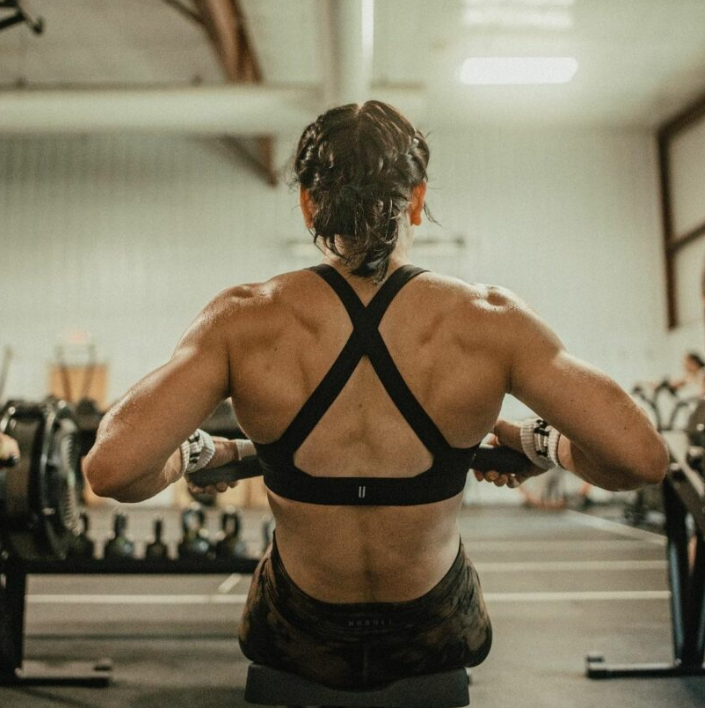
Yes and no.
If you suffer from lower back pain, a rowing machine won’t necessarily ameliorate it. It’s not a treatment. However, there are some positive effects in the long run, but it depends on what kind of pain it is.
Evaluate the pain first, as well as your physical strength and endurance. If it’s an injury, wait until it’s completely healed.
If it’s caused by a hectic lifestyle or your job, keep your workouts mild.
Effects become visible in the long run. While a strong core is necessary for rowing, starting at the lowest setting can push you forward. The more you do it, the stronger your core will get.
And that’s what’s going to keep lower back pain under control. It’s a long term effect, not an immediate one.
Can I Use a Rowing Machine with Degenerative Disc Disease?

The degenerative disc disease is not an actual disease because causes are not perfectly clear. Some say it’s a genetic issue, others blame it on traumas, like accidents. The natural aging process will also contribute to it.
The issue affects those gel cushions between vertebrae. They’re no longer soft, but brittle and hard, causing pains and discomfort.
Different people experience it in different ways.
So, the use of a rowing machine with degenerative disc disease should be evaluated based on individual factors, such as severity of the condition and fitness level.
As always, it's recommended to speak with a healthcare professional before starting rowing workout. However, some people with this condition may experience pain relief from light workouts.
Physical activity can help reduce pain, but it's important not to overdo it, as this can cause more discomfort in the long run.
Can I Row with a Herniated Disc?
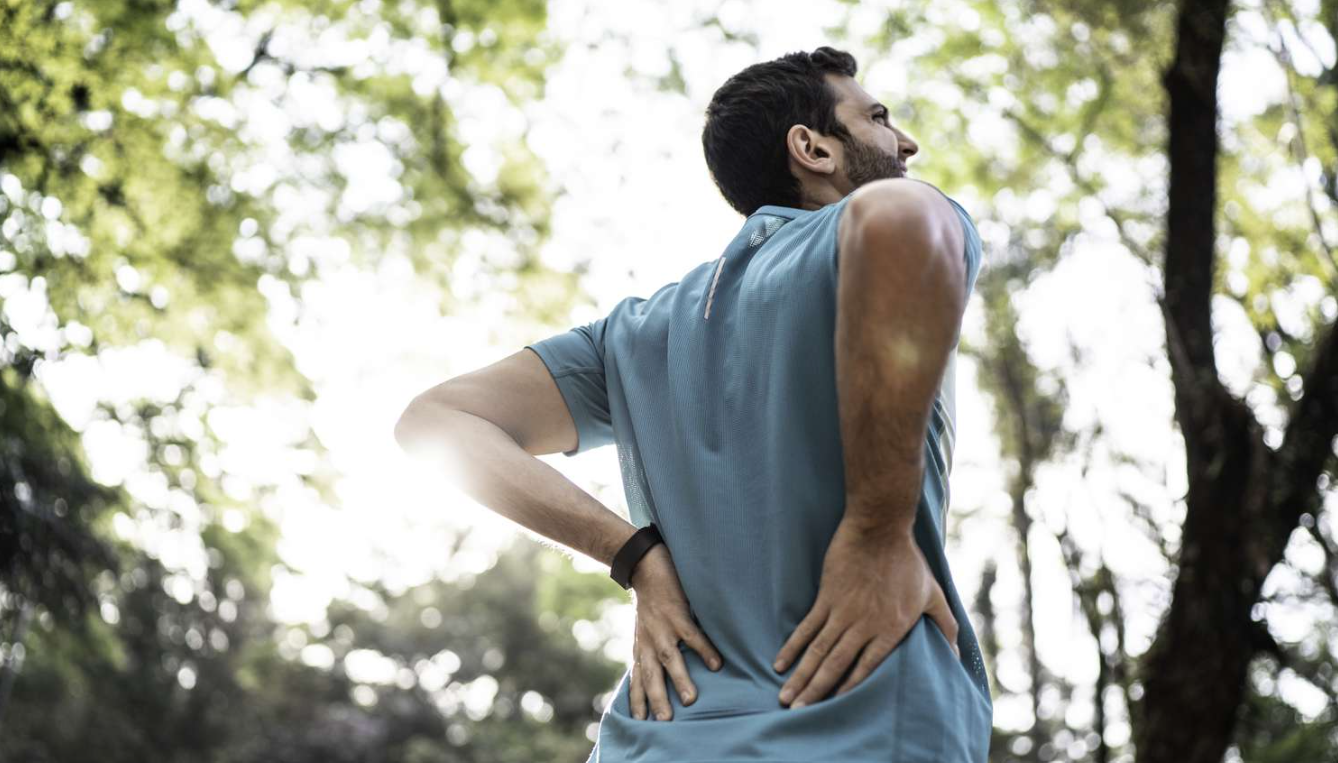
Herniated discs, which occur when the small cushions or discs between vertebrae are damaged and bulge out, can cause pain and discomfort.
While physical activity can help strengthen the back and prevent herniated disc problems, certain precautions need to be taken.
High-impact exercises such as russian twist and its alternatives which require excessive arching or twisting of the back should be avoided. After experiencing a herniated disc, it's recommended to wait a few weeks before engaging in any physical activity, including rowing.
Starting with the lowest possible setting is also advised, as overdoing it can worsen the problem.
It's important to discuss exercise options with a healthcare professional to determine what is safe and appropriate for individual recovery times and needs.
With time and proper care, most herniated disc problems will resolve on their own.
How to Prevent Back Pain and Injury While Rowing
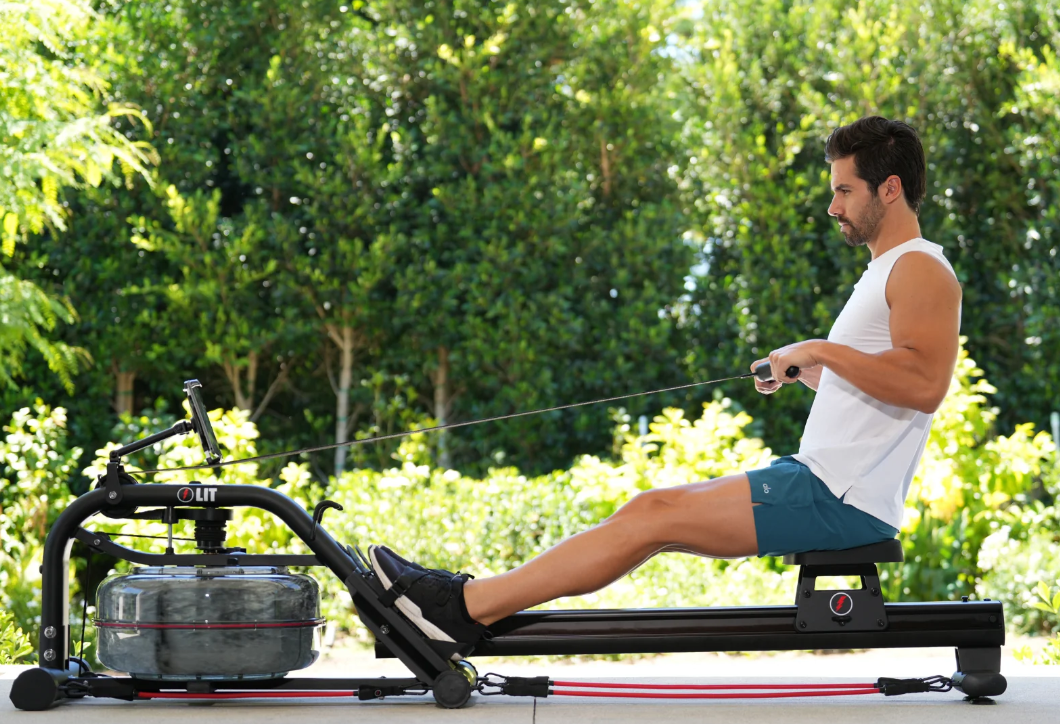
There are a few tips and tricks to ensure you gain as much as possible from such a workout. Some of them make sense, some others are often overlooked.
Most importantly, maintain the right posture and focus on keeping the back straight. Second, avoid overtraining. This rule applies to any type of workout, of course, not just rowing.
It pays off pushing yourself a little because that’s how you grow muscles and strengthen them, but then, overtraining will exhaust them and can actually aggravate back pains.
Pay Attention to Your Body’s Response
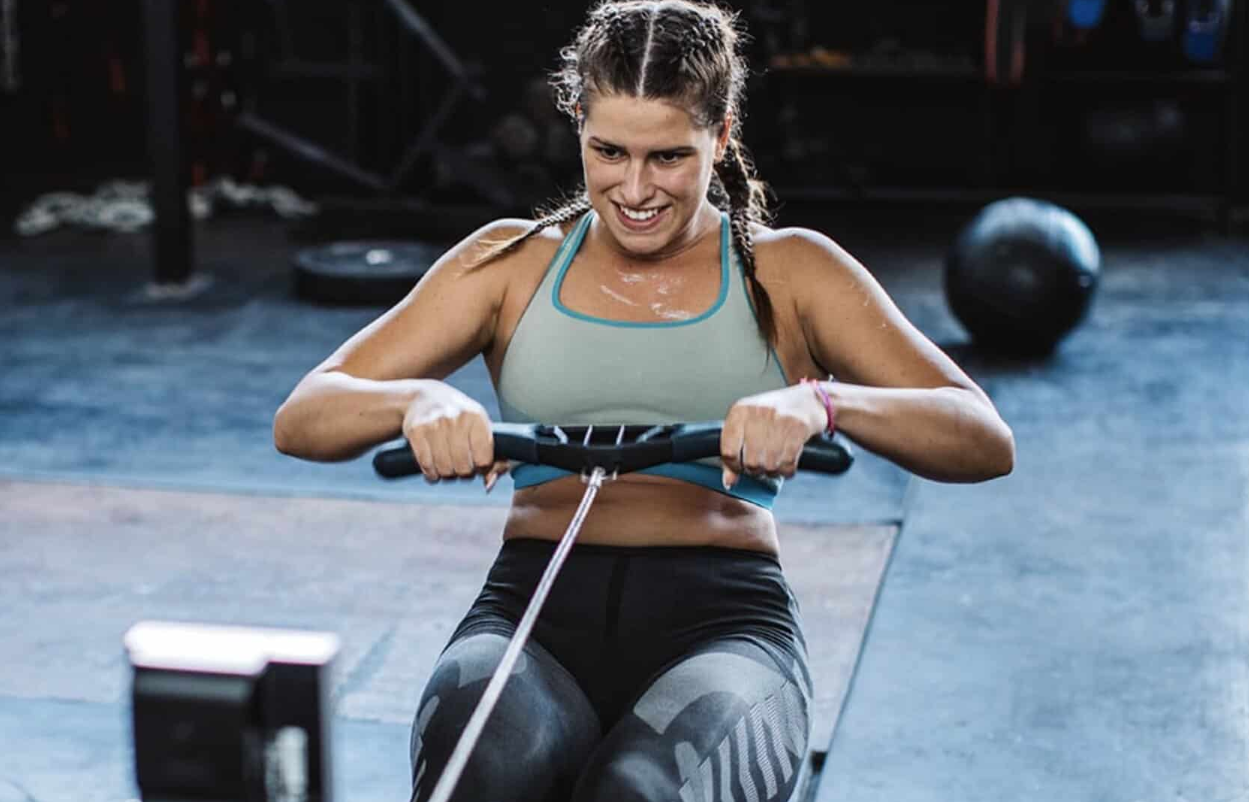
Generally speaking, most muscles work in pairs. One muscle gets tight and the other one relaxes and so on. The whole body works on such principles, but don’t worry, I’m not here to give you a lesson of anatomy.
Lower back is associated with the abs. Makes sense, they’re all part of the core. When the rowing movement engages your back, your abs need to be strong enough to support it.
If you have terrible abs, there will be too much pressure on your back. Basically, if your back feels tight after a mild workout, it’s time to work on the abs first.
Do it Gradually
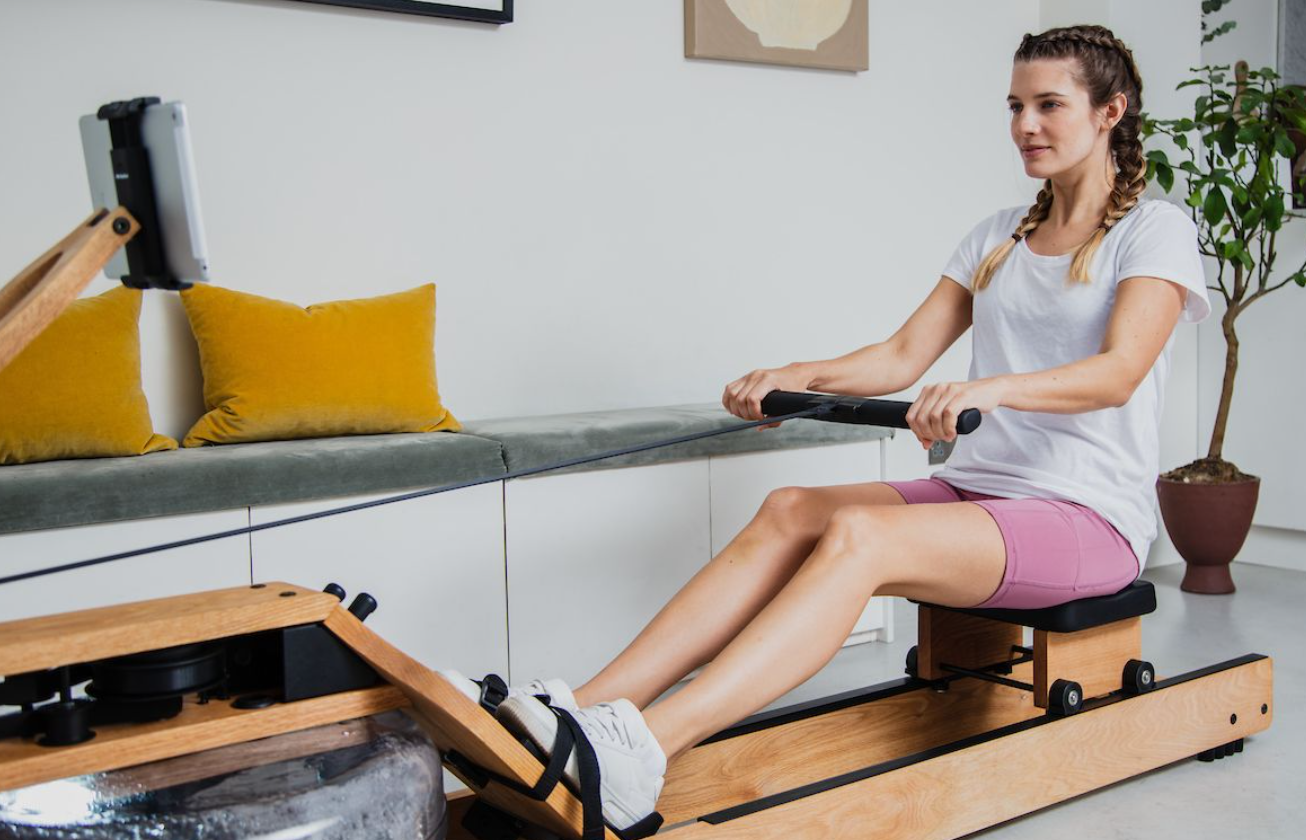
Always start with the lowest setting, there’s no rush whatsoever. If you push hard from the beginning, you risk causing injuries.
And like I said earlier, no matter how easy the exercise feels in the beginning, it will hit differently after 20 minutes or so.
Do a few minutes more tomorrow and so on. Increase the tension little by little every week.
Don’t Skip Warming Up
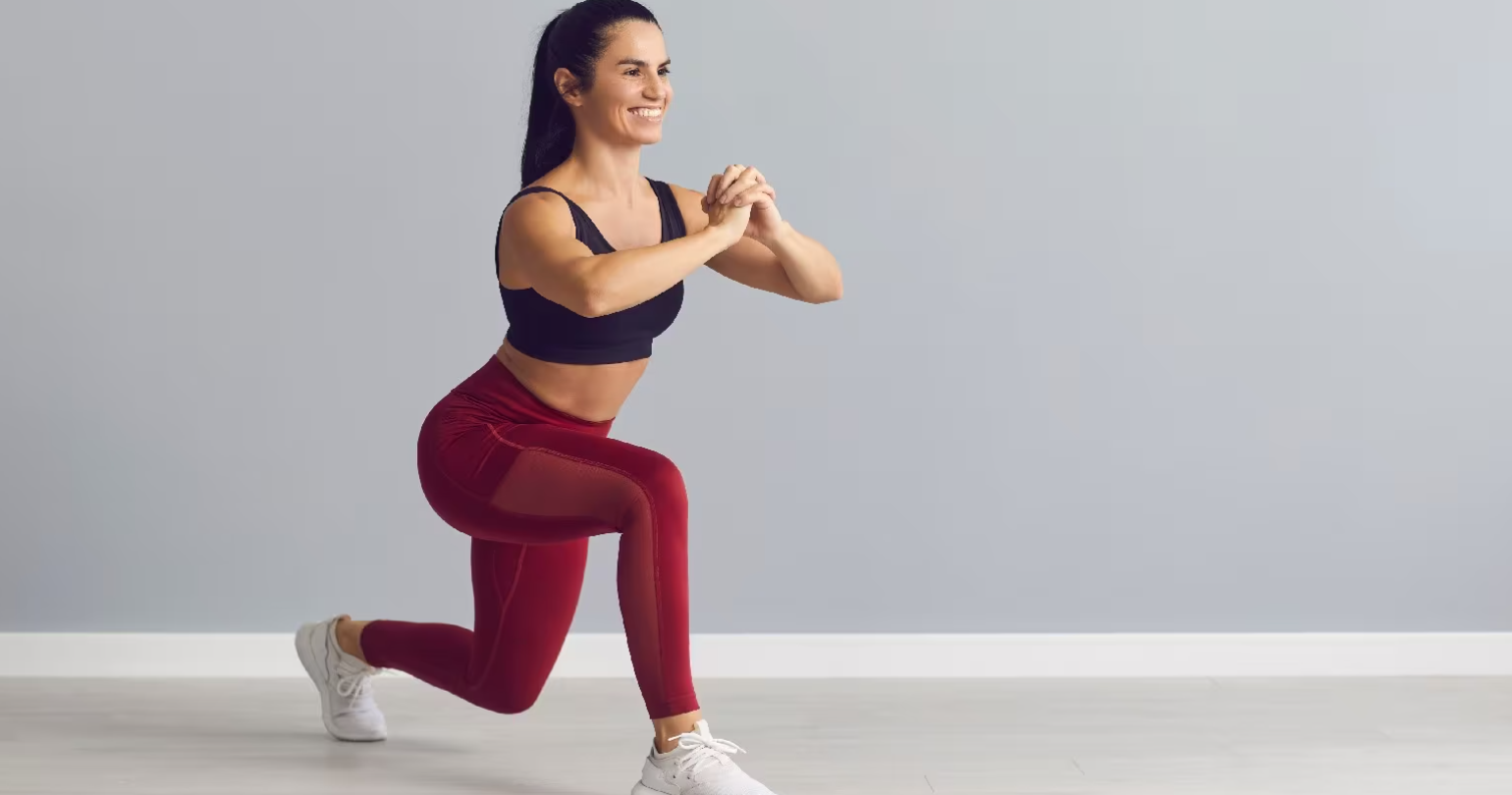
Warming up is critical, whether you use a random machine in a gym or you have the best heavy duty rowing machine out there.
Warming up will only need a few minutes and can prevent a lot of injuries. You need the heart running and the muscles ready for action.
Flexibility is just as important, especially in your hamstrings. Yoga, stretching moves, a few jumping jacks, jump rope, jogging, butt kicks, these things will do.
Mix with Other Exercises
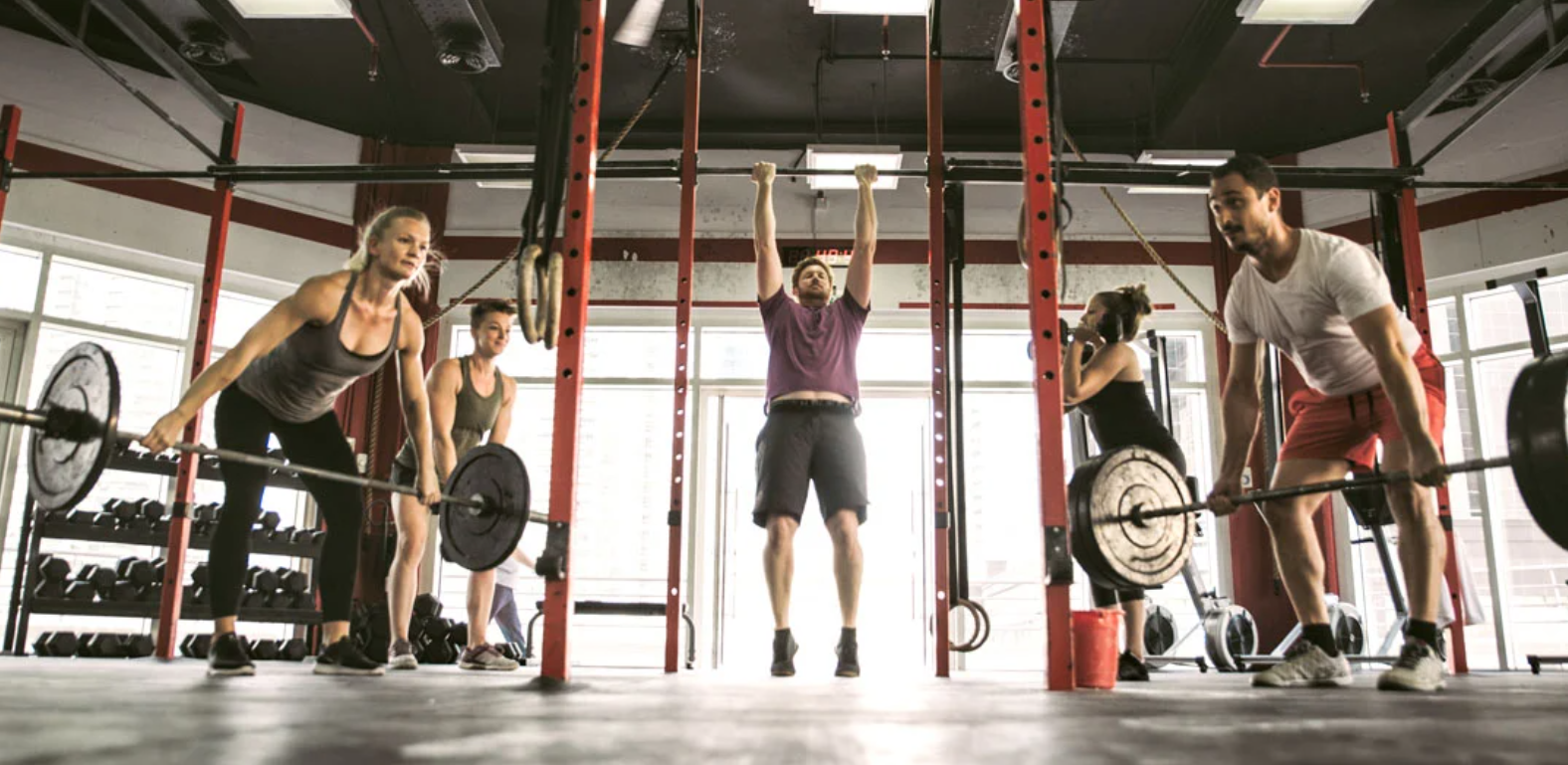
Rowing is doable with any type of fitness. Better fitness will obviously give you better results. To avoid back pain, you can mix it up with other similar exercises.
Focus on aerobic workouts. Cycling is a good idea, but a jog will also do. Such workouts a couple of times a week will prevent injuries associated with overtraining.
Frequently Asked Questions

Still got more questions about whether rowing machines can be bad for your back? Here are some more answers for y'all;
What are the Side Effects of Using a Rowing Machine?
Some workouts can be tedious and after a while, they get a bit boring. Personally, I watch a movie or some series while rowing, it helps with distractions. Other than that, a toll on the lower back is another potential side effect, especially if you don’t follow the right technique or you go too fast.
Can I Use a Rowing Machine Everyday?
If you experience no tightness in affected muscles, especially the back, there’s nothing wrong with doing it daily. Exercising on a daily basis will help you reach your goals faster, whether you’re worried about your back pain or you want to shed some pounds before your next seaside holiday.
Final Thoughts
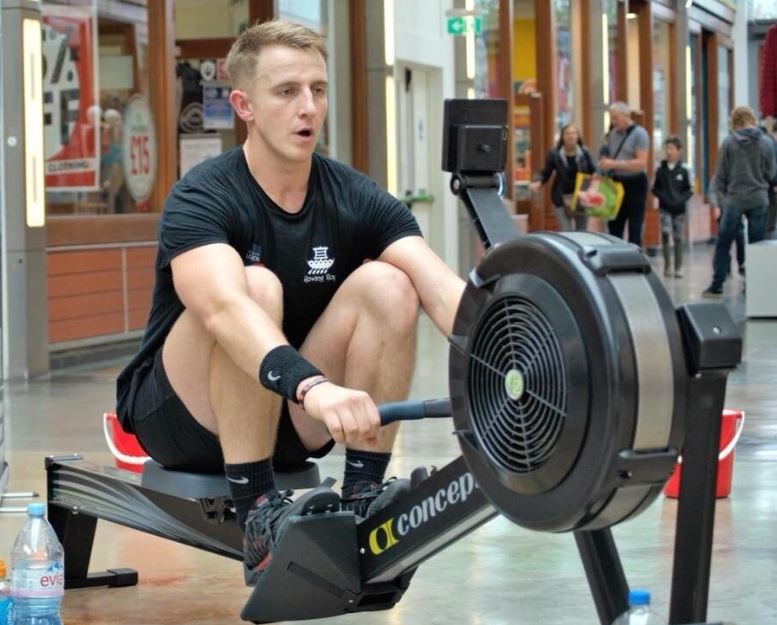
Are rowing machines bad for your back? Rowing can be excellent for your back, but not if you’re injured or you experience severe pains for various reasons.
It’s a good exercise for maintenance, toning up and even ameliorating back pains if they’re mild and caused by your lifestyle.
Like with everything else, it’s imperative to seek medical advice first, especially if you already have pains.
If you’re just trying to prevent them or strengthen your core a little, go ahead and get ready for a full body workout that will help you get fit in no time.
Related Articles:
Water crunches
Do Pull Ups Work Abs?
Concept 2 Rower vs. Skierg
The Lat Pulldown vs Seated Row
References:
- https://www.litmethod.com/blogs/boltcut-blog/is-rowing-good-for-your-back
- https://boxlifemagazine.com/is-rowing-machine-good-for-your-back/
- https://www.rowingcrazy.com/is-a-rowing-machine-bad-for-your-back/
- https://rowingmachineking.com/rowing-machine-back-pain/
- https://www.rowingcrazy.com/rowing-machine-and-degenerative-disc-disease/
- https://exercise.co.uk/learn/is-a-rowing-machine-good-for-a-bad-back/
Ben Mayz
Hi there! I'm Ben, main author and chief editor at Fitlifefanatics.com. I have been obsessed with Strength Training and Fitness for 18 years now.
My passion for living a happy fit lifestyle is what made me realize that fitness is what I wanted for my future.
I went on to earn my Masters in Sports Training & Biomechanics.
My passion for Strength training & fitness and my love of helping others is what made me start Fitlifefanatics.
Here, myself, and a team of specialist aim to provide the most accurate, and actionable information possible in hopes to help foster the fitness community forward.
You can learn more about Fitlifefanatics on our About Page

